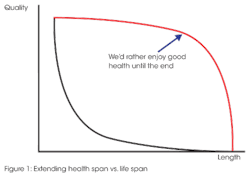Marketing has painted a target on these consumers, but how far should dentistry go?
By Patti DiGangi, RDH, BS
"There are several things you can do to look and feel younger. All the experts agree, though, that the No. 1 thing is to be born later." – From Humor for Boomers
One day recently, my husband asked me, "Will we end up with dentures?" As a hygienist of many years, I looked at him and said, "Huh?" He asked me a second time, and again I was dumbfounded. I couldn't even vaguely understand why my husband of so many years could even think that it would be possible. Then the lightbulb came on; we are bombarded daily with advertising for one-day dental implants.
-------------------------------------------------------
Other articles by DiGangi:
-------------------------------------------------------
Marketers have been gearing up for the aging baby boomers. We see a Walgreens, CVS, Rite Aid, or whatever pharmacy chain popping up on every corner. Target, Walmart, and the discounters are adding pharmacies. Sam's Club and Costco offer hearing and vision services. Each of those retailers is gathering statistics about buying patterns.
How is dentistry and dental hygiene gearing up for the baby boomers? Can we continue to accept the recidivism of oral health diseases? What are their buying patterns?
Mad about getting older, but some of it's good
By now, most of us have heard the statistics that every day starting Jan. 1, 2011, 10,000 people turn age 65. That pattern will continue through 2030. Paul Taylor in his 2014 book, The Next America, says baby boomers are just starting to realize they are getting older and are truly mad about it.
Baby boomers are happy, as compared to the generations before them, that they have kept their teeth. A hundred years ago, brushing one's teeth was not routine in America, which is hard for us to imagine in 2014. Mr. Claude Hopkins, a name you probably don't know unless you are in the advertising business, changed our world by making routine toothbrushing a habit. Prior to his marketing campaign, only about 7% of Americans had a tube of toothpaste in their medicine cabinets. Mr. Hopkins found simple triggers to convince people to use his products every day. His campaign was based on the notion that toothpaste could create beauty.
Baby boomers were positively affected by this change of habit. The toothbrushing habit was ingrained. Boomers have kept their teeth by making an extensive investment in professional care with full-mouth reconstruction, implants, and the myriad care provided by oral health professionals. How can we help protect them for the next 20-plus years that most will live?
As the baby boomers reach their later years, it is expected that their health will decline. Yet this doesn't have to be the case. Rather than health declining with age, it is possible to extend good health to the end of our lives (see Figure 1). This must include good oral health.
Important concepts on aging can only be understood by looking at healthy, independently living people over a number of years. Most dental research comes from a disease-based model. This is also the case for most medical research, yet not all of it. In 1958, William Peter, MD, a retired physician and former missionary, decided to donate his body to science while he was still alive. He wanted to study normal aging. This became the basis for the National Institute on Aging (NIA) Baltimore Longitudinal Study on Aging (BLSA) (www.grc.nia.nih.gov/branches/blsa/blsa.htm).
This ongoing study celebrated its 50th anniversary in 2008, and it is still actively recruiting. The BLSA has a wealth of information. Three major conclusions from their studies must be internalized for health in later years to become better:
- Normal aging can be distinguished from disease.
- Change is normal; disease is not inevitable.
- There is no chronological timetable of human aging; we all age differently.
As we age, we start misplacing glasses, losing car keys, or asking, "Why did I walk up these stairs?" At the office, the question is, "Did I say this to this person or the last person in my chair?" On average, forgetfulness begins at age 35. Aging is a factor, yet that is too simple to be the only answer.
In the past few years, there has been an explosion of data available. Millions of websites are at our fingertips. The flow of data, information, and knowledge is growing exponentially, stretching the capacity of our brains. Big data is a popular term used to describe this exponential growth and availability of data about nearly everything. Data itself is raw potential; it becomes information when it becomes useful.
Target stores have had a lot of bad press since their data security breach last year. Prior to that, Target had been known for its excellence in data-mining. Data-mining is the process of analyzing data from different perspectives and summarizing it into useful information that can be used to increase revenue, cuts costs, or both. Target assigns every customer a Guest ID number, tied to his or her credit card, name, or email address. This number becomes a bucket that stores a history of everything the customer has bought and any demographic information Target has collected from him or her or bought from other sources. Target has gotten so good at mining that it can predict when a woman will get pregnant. They then begin sending coupons for baby items to customers according to their pregnancy scores. An angry father confronted a store manager about sending these coupons to his teenage daughter; little did the father know until later that his daughter was pregnant.
ADA and best practices
What does that mean for dentistry? It means more and more data from research and data from our patients. As people live longer with their teeth and have more complex health issues, we could easily feel buried. Electronic health records (EHR) can help us dig through it all and take huge amounts of data and create useable information.
The ADA Center for Evidence-Based Dentistry (EBD) (ebd.ada.org/) is a portal that will have significant influence in the future. EBD is a patient-centered approach to treatment decisions, which provides personalized dental care based on the most current scientific knowledge. This portal will play a major factor in the future with EHR.
Clinical treatment guidelines are some of the best and quickest ways for health-care providers around the country to learn the science behind making the best clinical decisions for their patients. Generally, a panel of experts is convened to review the scientific literature and create informed treatment recommendations. Experts crafting guidelines explain which treatments are helpful to the greatest number of people within a certain patient group. Carrying the official backing of established societies, the implications of the release of guidelines are many. In theory, health-care professionals review the new guidelines, weigh the scientific evidence, and implement the new best practices. In addition to the practitioners, insurance carriers also know what are considered best practices.
The ADA Center for EBD is accomplishing this process in dentistry. The Clinical Practice Guidelines description states: “Clinical practice guidelines include recommendation statements intended to optimize patient care that are informed by a systematic review of evidence and an assessment of the benefits and harms of alternative care options. These are the strongest resources to aid dental professionals in clinical decision making and help incorporate evidence gained through scientific investigation into patient care” (ebd.ada.org/en/evidence/guidelines).
The list of current ADA Clinical Practice Guidelines is shown in Table 1. What is interesting is how many of these items come most often in the dental hygiene realm of practice. The guidelines have the official backing of the ADA and will be considered best practices by insurance carriers and others.
What are the best practices for baby boomers and older adults? Has this been factored into these guidelines? The challenge is at the current time, there is little research specific to older people keeping their teeth and dentistry. Are they different than younger people?
Mining patient data exercise
National Dental Practice-Based Research Network (nationaldentalpbrn.org) is a network to gather practical science done about, in, and for the benefit of real work in everyday clinical practice. This very important work will add to the body of research. At this time, there are no ongoing practice-based studies specific to our aging population. We have our patient charts each with a gold mine of data.
Here is an easy exercise to see what gold your charts may show. Whether your records are paper-based or electronic, select 10 random charts for some of your baby boomer patients. Have a blank paper pad handy. Read a chart from beginning to end, and write down what seems significant. There is no right or wrong to this exercise; just write down what you notice. You might see a health pattern for this patient. You might see unaddressed needs and wants. You might see that the record keeping has some holes. After you have read all 10, compare your lists. Think about these questions:
Do all charts read basically the same?
- What did you find?
- Are there patterns?
- What are the patients' buying patterns? (Yes, our patients “buy” dentistry.)
- How might you approach, think about, talk with this patient differently based on what you found?
- Do you need to consult with the patient's physician in ways you might not have considered before?
- Has there been a decline?
- Has there been recidivism?
Many of us have seen when decline happens with aging adults. Patients who previously had impeccable home self-care come in with soft plaque buildup you can measure in inches along with calculus. Have you wondered why they don't seem to feel that buildup? Research does support some declination in the sensory area with aging (even if the baby boomers don't like to admit it). This change in the sense of taste, touch, and vision can lead to plaque-laden reality; patients might truly not feel, taste, or see the buildup as they once did. Yet, it may not all be only on the patient's end. Could the patient's recidivism be related to habits and beliefs?
Recidivism is the term used when criminals keep going in and out of prison. It is defined by Webster's as “the tendency to relapse into the previous condition or modes of behavior.” Most dental hygienists, as well as dentists, believe oral disease is something to be managed rather than cured. There is an expectation of recidivism; in other words, we expect decline and falling back. We wait for and expect disease. But wait, you are a hygienist with a commitment to prevention. If that is the case, why is it when you are probing you are looking for pockets and bleeding? Scratching around with an explorer to find cavities to repair? Palpating soft tissues seek overt lumps and bumps that could be cancer? You are looking for late-stage manifestations of disease. The way hygiene has been traditionally practiced is a form of insanity. We do the same things over and over and expect a different result. We can turn these thoughts and expectations of disease upside down by changing our goals and belief in health.
Routine order of the day
Technological innovations can become the backbone of maintaining oral health when these shifts occur. All our patients can benefit -- not just baby boomers. Many patients love the idea of purchasing power brushes, rinses, dry mouth products, and a variety of other options at the dental practice based on professional recommendations. Of course, patients will ask: “Does my insurance cover it?” With the aging baby boomers losing dental benefits with retirement, they will ask if Medicare will cover it. Our habit-based behavior is an automatic no!
For many of us, routine is the order of the day. When patients ask anything about their insurance, it is heard as "they won't have whatever care is being presented if insurance doesn't cover it." This assumption is often incorrect and a self-fulfilling prophecy. "What we believe, we achieve" becomes real. We believe patients will reject care, and that is exactly what happens. Changing our expectations is the challenge because for real change to happen, we need to change our habits.
The response to this dread insurance question isn't as simple as it might appear. Prevention has not traditionally been valued by carriers, providers, or patients. That thought doesn't sit well for many, yet it is true. The basis of our health-care and benefits system has been disease-based: "If it ain't broke, don't fix it."
This is changing. In 2009, Mr. Richard Celko, Aetna's national dental director of utilization management, said, "The nation's largest dental carriers (Aetna, BCBS, CIGNA, Delta, MetLife, etc.) have been tracking their internal data for years. The preponderance of evidence suggests that it makes more economical sense to the patient, insurance carrier, and the employer purchasing the plan to pay for prevention rather than paying for the restoration or extraction of teeth. As a result, some of the nation's largest dental plans are covering more preventive and diagnostic services in hopes of avoiding more costly and invasive restorative services in the future."
This emphasis on prevention, which is so much more than just prophies and fluoride, will take a real change in habit for the entire team, starting with hygienists, to believe and act differently.
Deeply ingrained habits are common for many baby boomers. Habits are important. Habits are comfortable. Yet it is time to look at our own habits and determine if they are still serving us. Automatic routine beliefs and responses need to change. A quote from my book DentalCodeology: Jump Start Diagnostic Coding applies here and on many levels: "If coding is the same for everyone, or you think you already know the codes, you are not doing it right. To do it right, you must think and understand."
Habits are not destiny. The past does not have to predict the future. My husband will not lose his teeth. Our world is constantly is changing, and we must adapt. What we believe, we truly can achieve.
ADA clinical practice guidelines
Table 1
- Topical fluoride (updated November 2013)
- Prevention of orthopedic implant infection
- Nonfluoride caries preventive agents
- Reconstituting infant formula
- Screening for oral cancer
- Sealants
- Infective endocarditis (IE)
- Treating tobacco use and dependence
Patti DiGangi, RDH, BS, continues to take an active, future-oriented leadership role in a variety of professional organizations. She is a certified Health Information Technology trainer and author of the DentalCodeology series of easy-to-read, bite-size books on coding. Patti is an ADA Evidence-Based Champion and holds a publishing license with the American Dental Association for Current Dental Terminology. She is the 2013 Sonicare/RDH Mentor of Distinction winner and 2014 Sunstar/RDH Award of Distinction. She can be reached at [email protected].
Past RDH Issues







